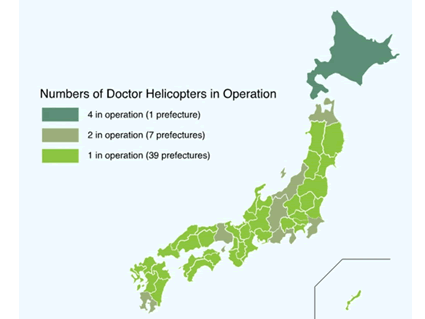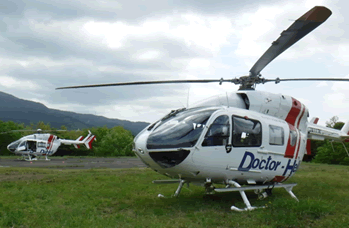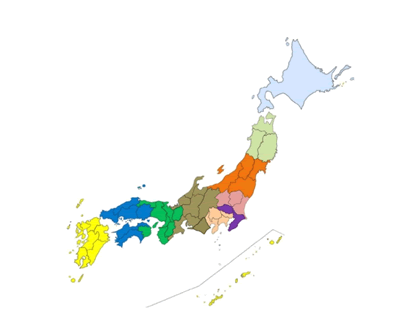Commentary Article - (2023) Volume 8, Issue 3
Commentary on “Importance of a Collaboration Agreement in the Management of Physician-Staffed Helicopters” in Japan
Youichi Yanagawa*
Department of Acute Critical Care Medicine, Shizuoka Hospital, Juntendo University, Japan
*Correspondence:
Youichi Yanagawa,
Department of Acute Critical Care Medicine, Shizuoka Hospital, Juntendo University,
Japan,
Email:
Received: 31-May-2023, Manuscript No. IPJHCC-23-16583;
Editor assigned: 02-Jun-2023, Pre QC No. IPJHCC-23-16583 (PQ);
Reviewed: 16-Jun-2023, QC No. IPJHCC-23-16583;
Revised: 21-Jun-2023, Manuscript No. IPJHCC-23-16583 (R);
Published:
28-Jun-2023, DOI: 10.36846/2472-1654-8.3.8023
Description
A physician-staffed helicopter is called a doctor helicopter
(DH) and it is capable of quickly bringing a doctor and nurse
to an emergency site. The DH stand by at base hospitals, ready
to respond to dispatch requests, and is equipped with medical
equipment and medicine needed for initial treatment. As
of April 2023, 56 DHs have been deployed in 47 prefectures
across Japan, covering approximately 378,000 square kilometers
and serving 124.5 million people. There are four DHs in
Hokkaido Prefecture, two each in Aomori, Niigata, Chiba, Nagano,
Shizuoka, Hyogo and Kagoshima Prefectures, and one in
the remaining prefectures (Figure 1) [1]. When a 119 emergency call comes in at the Fire-fighting Central Command Room,
an ambulance is dispatched to the scene, and a request for
DH dispatch is sent to a base hospital. The DH carrying staff
on board lands at the Rendezvous point, the staff enters the
ambulance, and they immediately begin treating the patient.
The Rendezvous Point is the location for landing and take-off
at the emergency scene where the ambulance meets the DH.
These points are selected in advance by the Flight Coordination
Committee in each prefecture. The committee selects locations
such as schoolyards, parking lots and parks. There are approximately
600 Rendezvous Points per base hospital. In addition to
these emergency dispatches, the DH also transports patients
between medical institutions as interfacility transport.

Figure 1: Distribution of doctor helicopters in each of the 47 Prefectures. There are four DHs in Hokkaido Prefecture, two each in Aomori, Niigata, Chiba, Nagano, Shizuoka, Hyogo and Kagoshima Prefectures, and one in the remaining prefectures
There are two key collaboration agreements in the management
of multiple DHs: The mutual support agreement during
peacetime and the mutual support agreement during catastrophic
disasters. The purpose of the agreement during
peaceful times covers responding to overlapping requests for
dispatch, addressing multiple injured patients simultaneously,
and cooperating when it is impossible to dispatch DH due to local
conditions or mechanical issues across prefectural borders.
In 2014, it was made possible to request DH dispatch from other
prefectures even in situations where the DH from the local
prefecture could be deployed if such a dispatch would allow for
faster treatment and transport, based on the agreement [2].
The difference in time required for transportation is a crucial
factor in life-or-death emergency medical care, so this relaxation
of requirements can be seen as a significant advancement
and provides double and triple safety nets.
Of the 47 prefectures in Japan, only 7 (Okinawa, Miyazaki, Oita,
Kumamoto, Tokyo, Kagoshima and Hokkaido) do not have such
an agreement with neighboring prefectures. Among them,
Kagoshima and Hokkaido both have multiple DHs, which are
used when necessary. In the Kansai Wide-Area Union, which
expands the neighboring prefectural agreement, seven DHs are
deployed together and operated across the seven prefectures included in the Union. This agreement is the largest agreement
in Japan and has a flexible operational structure that is not
bound by prefectural boundaries.
One of the largest prefectures, Shizuoka, which has two DHs
in its eastern and western regions, has unique agreement with
neighboring Prefectures. Eastern Shizuoka has an agreement
with Yamanashi and Kanagawa Prefectures, and Western Shizuoka
has an agreement with Nagano and Aichi Prefectures.
Based on the collaboration agreement, there have been a number
of dispatches for mutual coverage in the eastern regions
where medical resources are limited [3-5]. Recently, a car collision
involving two vehicles occurred, resulting in four seriously
injured individuals. During that incident, three DHs-one each
from the eastern and western regions of Shizuoka Prefecture
and Kanagawa Prefecture-utilized a single rendezvous point
to transport critically ill patients (Figure 2). In the neighboring
prefectural agreements, the prefecture that dispatches the
DH bears the operating expenses. Requesting assistance from
another prefecture can impose a financial burden, which may
result in hesitance to make such requests. Ongoing discussions
are thus necessary to determine how to distribute the expenses
among the participating prefectures.

Figure 2: Rendezvous point for car accidents. Three doctor helicopters in Western and Eastern Shizuoka and Kanagawa Prefecture collaborated to manage multiple injured patients
The other key collaboration is the Mutual Support Agreement
during catastrophic disasters. Catastrophic disasters involve
large numbers of injured people who need to be transported
in a short time to locations spread out over a wide area outside
the disaster zone. In the Great East Japan Earthquake, multiple
DHs were dispatched for the first time to the disaster area
without any agreements in place [6]. The operation of DHs had
not been incorporated into the national disaster management
basic plan, and there were no established grounds or command
structures for their activities in the affected areas. In such circumstances,
coordination with fire departments, self-defense forces and other organizations was not effectively achieved. The
Japanese government subsequently began reviewing its disaster
prevention basic plan.
In 2015, guidelines for establishing the operational framework
of DHs in the event of catastrophic disasters were provided by
the Ministry of Health, Labour and Welfare to each prefecture,
thereby establishing rules. First, aviation operation coordination
teams including DHs are stationed at the prefectural offices of
disaster-affected areas, enabling coordination with helicopter
operators, such as fire departments and the Self-Defense Forces. Second, the maximum response range for the DHs during a
catastrophic disaster is within a radius of 300 kilometers from
the center of the affected area. Third, when a DH enters the
disaster area, it creates a gap in the operational area of all DHs
in that region. To cover that gap, Japan’s 47 prefectures are divided
into 10 blocks (Figure 3), and the general practice is to coordinate which DH from that block will be dispatched to the
disaster area. Once the DH to be dispatched is determined, the
remaining DHs within the same block cover the vacuum in their
assigned areas to avoid creating any gaps. Fourth, DHs can take
off and land freely during a disaster.

Figure 3: 10 blocks covering catastrophic disasters in Japan's 47 prefectures. Once the DH to be dispatched is determined, the remaining DHs within the same block cover the vacuum in their assigned areas to avoid any gaps
Furthermore, a number of new systems have been developed.
In the Great East Japan Earthquake, it was difficult to track the
locations of helicopters. Therefore, satellite communication
was utilized to enable real-time tracking of all 57 DH locations
[7]. The lessons from the Great East Japan Earthquake were applied
during the Kumamoto earthquake that occurred in April
2016 [8]. Japan is a small island nation with a high population
density, so it employs various measures to prepare for both everyday
disasters and large-scale catastrophic events.
Acknowledgement
This work was supported in part by a Grant-in-Aid for Special
Research in Subsidies for ordinary expenses of private schools
from The Promotion and Mutual Aid Corporation for Private
Schools of Japan.
Conflict Of Interest
The authors declare no conflicts of interest.
References
- HEM-Net. Bases.
- HEM-Net. News Archive.
- Yanagawa Y, Jitsuiki K, Iwasa F, Miyake A, Tosaka N, et al. (2022) Importance of a collaboration agreement in the management of physician-staffed helicopters. Air Med J. 41(1):52-56.
[Crossref] [Google Scholar]
- Jitsuiki K, Omori K, Takeuchi I, Kondo A, Ohsaka H, et al. (2018) Multiple patients with heatstroke air evacuated by agreement concerning collaboration. Air Med J. 37(6):388-391.
[Crossref] [Google Scholar]
- Kondo A, Jitsuiki K, Osaka H, Takeuchi I, Ishikawa K, et al. (2019) Multiple patients with burn injury induced by a chemical explosion managed by physician-staffed helicopters. Disaster Med Public Health Prep. 13(4):799-805.
[Crossref] [Google Scholar]
- Matsumoto H, Motomura T, Hara Y, Masuda Y, Mashiko K, et al. (2013) Lessons learned from the aeromedical disaster relief activities following the great East Japan earthquake. Prehosp Disaster Med. 28(2):166-169.
[Crossref] [Google Scholar]
- Weather News. All Doctor Helicopters nationwide have implemented a dynamic management system.
- Motomura T, Hirabayashi A, Matsumoto H, Yamauchi N, Nakamura M, et al. (2018) Aeromedical transport operations using helicopters during the 2016 Kumamoto earthquake in Japan. J Nippon Med Sch. 85(2):124-130.
[Crossref] [Google Scholar]
Citation: Yanagawa Y (2023) Commentary on “Importance of a Collaboration Agreement in the Management of Physician-Staffed Helicopters” in Japan. J Healthc Commun. 8:8023.
Copyright: © 2023 Yanagawa Y. This is an open-access article distributed under the terms of the Creative Commons Attribution License, which permits unrestricted use, distribution, and reproduction in any medium, provided the original author and source are credited.




